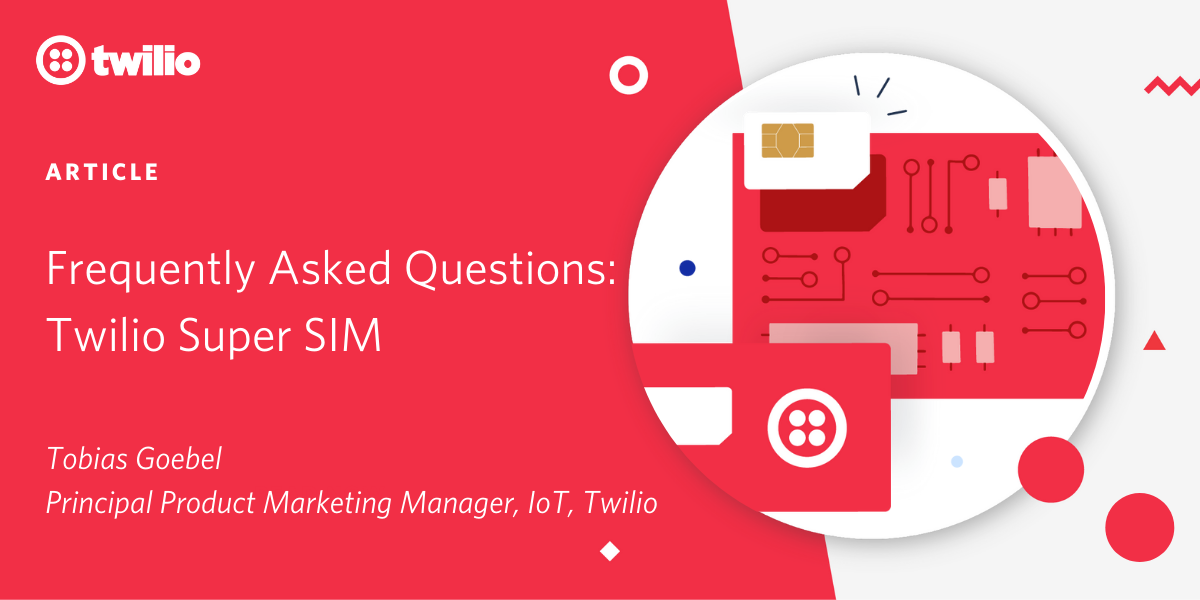Frequently Asked Questions: Twilio Super SIM
Time to read: 4 minutes

Whether you’re a new IoT device builder or have years of experience under your belt, you may not be aware of all the innovation happening around cellular connectivity in particular. For example, did you know that there is a solution that’s overcoming the challenges of legacy carrier or reseller approaches to IoT SIM cards?
Meet Twilio Super SIM. We recently went GA (Generally available) with Super SIM and marked the occasion with a webinar where we summarized what it is and how it solves the challenges of cellular IoT connectivity. Besides the positive feedback, the number of questions from our audience was overwhelming.
We’re addressing your most pressing questions in this blog.
Let’s get started.
Where do you provide coverage maps showing total coverage of Super SIM?
Super SIM offers access to almost hundreds of networks in over 170 countries across various radio access types, including 2G, 3G, 4G-LTE and Cat-M. You can see what networks are offered on Super SIM by visiting the Super SIM Available Networks page.
How does Cellular IoT compare to the LoRaWAN IoT protocol?
The radio access type that is most competitive with LoRaWAN for its long range and low power capabilities is LTE Cat-M, also known as LTE-M. Twilio Super SIM offers many Cat-M networks today, and carriers are actively rolling out more and more Cat-M coverage around the world. We recommend taking a serious look at Cat-M, as it is licensed broadband cellular. See also A Look at the Fragmented Landscape of IoT Connectivity and When to Use LTE Cat-M for IoT Devices from the Twilio Blog for more information.
How does the failover work in case of an outage of an individual network? Is there a need for special code to handle the failover on the device side?
The failover in case of a particular network’s outage happens fully automatically with Twilio Super SIM, through an intelligent interplay between our SIM and the modem. The modem will re-establish the connection to an available network, and no custom code is required to handle the failover, as that logic is already part of our SIM’s functionality.
Do you have a list of recommended modem eval boards?
We do not have particular recommendations. Twilio’s cellular connectivity is compatible with a wide range of devices from a variety of manufacturers. To help developers who need assistance or are running into difficulties, we’ve collected a number of common configuration requirements, errata, and solutions to common challenges for many of the modules we’ve worked with in our lab. Find that insight in our Cellular Module Knowledge Base.
With AT&T sunsetting their 3G network in February 2022, will this Super SIM card work with a 3G modem?
Super SIM can connect to other 3G networks in the US such as T-Mobile’s while they still exist; however, we do not recommend deploying any new devices that are dependent on 3G in the United States or anywhere else, due to the pending sunsetting of this radio access type (RAT) around the world. We generally recommend relying on 4G-LTE, as this generation is here to stay for much longer than the typical lifetime of a new IoT device, and many affordable modems exist that support it. We have gathered information on what to consider for a future-proof deployment in this post: 2G/3G Sunset: How to Future-Proof Your IoT Fleet
I understand you support CAT-M, do you also support NB-IoT?
Twilio offers NB-IoT on a dedicated SIM product, Twilio Narrowband, which provides access to the NB-IoT network of T-Mobile in the US.
How do I find out if my SIM is a Super SIM?
For Internet connectivity, you need to set the Access Point Name (APN) that an IoT device’s cellular modem will use. If all of your devices contain Super SIMs, this is straightforward: use the APN “super”. However, if your products contain SIMs from a variety of suppliers, including Twilio, you will first need to check which SIM a given device contains so that you can set the appropriate APN for that SIM.
Typically, to detect SIM type you read back the SIM’s IMSI. One of the key advantages of Super SIM is that it includes multiple IMSIs to enable switching between different local networks in the territory in which the host device is operating. This means that you should never use the current IMSI to determine whether a device contains a Super SIM. The IMSI reported by a Super SIM at any given time can and very likely will change. Instead, you can use the methods outlined in this article.
How much do your IoT SIM cards cost?
To see the introductory pricing for Twilio Super SIM, visit Super SIM Pricing. We offer custom rates and discounts for your production deployments. To benefit from these, please engage with our IoT experts.
How can I get started with Twilio Super SIM?
Getting started with Twilio Super SIM is made super easy.
- You can order a free trial SIM by signing up here. Once we have collected your address, we will ship you a triple-punch Super SIM free of charge.
- You can then follow along the steps provided in our Super SIM First Steps tutorial.
- We are also sharing information on how to use Super SIM with common hardware such as Raspberry Pis with a cellular modem from Sixfab – see here for more information.
These are just a few of the questions we received during the webinar. You can watch our webinar on demand to learn more about Twilio Super SIM.
Tobias Goebel is a technology practitioner and educator with almost 2 decades of experience in business software and product/solution development. After developing, architecting, and selling contact center and customer service technologies in the ‘00s, he moved to defining and evangelizing the potential and business benefits of artificial intelligence concepts and all sorts of emerging communications technologies in the 10’s, such as business messaging, chatbots, embedded voice & video, or multi-modal interfaces. As a product marketing principal at Twilio IoT, he now works on defining and evangelizing technology solutions that leverage the potential of connecting the physical world to the Internet.
Related Posts
Related Resources
Twilio Docs
From APIs to SDKs to sample apps
API reference documentation, SDKs, helper libraries, quickstarts, and tutorials for your language and platform.
Resource Center
The latest ebooks, industry reports, and webinars
Learn from customer engagement experts to improve your own communication.
Ahoy
Twilio's developer community hub
Best practices, code samples, and inspiration to build communications and digital engagement experiences.


